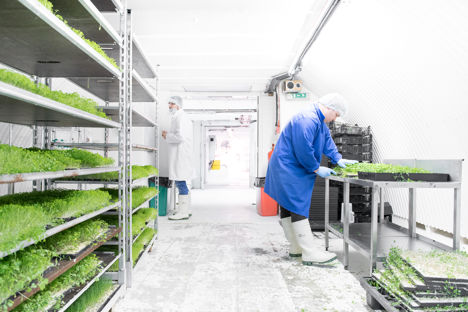
Clapham: not really known for its agriculture. It could be said that, if the words ‘underground’ and ‘farm’ were mentioned to Inferno nightclub and Revolution Bar’s regulars on a Saturday night, they’d have a very different idea to the hydroponic salad farm thirty-three metres below their feet.
But who knows? Maybe they’d like it. The candy floss-pink lights and neon-blue irrigation tubes look more synonymous with a casual rave than traditional farming. But then, at this WW2 air raid shelter turned salad and herb farm, hardly anything is considered traditional. ‘Our tunnel had 8,000 people down there during the war,’ says Growing Underground co-founder Steven Dring. ‘Designed so that, should they be bombed in, they’d be able to survive for three months by themselves.’
Right now, the only thing surviving here – and flourishing, at that – are pea shoots, mustard, coriander, amaranth, radish, celery, rocket, and parsley. Pretty well, too, when Steven and his team have ultimate control over the environment of their crop. ‘We had a polytunnel built for us,’ says Steven, ‘which gives a constant temperature all year round. It’s an ambient temperature of 14ºC, and when we put some LED lights in there, it takes the temperature to the right level.’
Ollie Lloyd talked to Growing Underground's founder Steven Dring on the FoodTalk podcast. To listen visit foodtalk.co.uk or download the podcast on iTunes or Podbean.
Those LEDs explain the pink lighting – different plants prefer different ambient light spectrums. A warm red, for example, is best for flowering plants. Blue, however, encourages leaf growth. Put them together (a pinkish purple) and you have the best of both. Though these LEDs don’t share the full light spectrum of the sun, they mimic the benefits of natural sunlight like a dream. With the right lights, some say it’s even better than the real thing.
Plus, it comes with another advantage – you can turn it off. ‘We turn the lights on for specific hours for each crop,’ says Steven, ‘and we sow onto agricultural matting which acts as the soil. We sow seed onto those, then flood the benches with an ebb and flow system two to three times a day. All our energy comes from renewables, and we power everything sustainably.’
Accounting for their inputs means Growing Underground are well on their way to reaching their goal of carbon neutrality. The fact they’re able to supply London very locally certainly helps that too, and it’s not just a boon for the environment – a salad could end up in someone’s kitchen fridge four hours after its picking. But that’s not to say there aren’t certain barriers in getting it there.
‘I’ve been in fields where they’re packing iceberg lettuce at a price, and the price of the retailer is lower than what the retailer buys it for,’ says Steven. ‘They’re using it as a loss-leader. That will always drive down the quality of the product. One of the positives we might take from Brexit is to look at agricultural policy and have an open debate about the quality of food.’
Even so, Growing Underground has earned the attention of Ocado, Waitrose, Wholefoods, and more sustainably-savvy outlets like Farmdrop and Planet Organic, who have all sold their produce at some point. It’s not just retailers though, as the products are loved and used by some of London’s most well-known chefs too.
As well as the obvious, it’s the story which attracts these buyers. And while Growing Underground certainly have a unique one, that novelty, as Steven says, should not be allowed to last long. ‘The next step is to move to growing more ubiquitous products and scale it that way. That’s when we have some serious impact, and then maybe we can reduce the cost of fresh produce.’
It looks like things are on the cusp of that happening. Growing Underground are looking at second and third sites, and, much like their original space, they’re not the first places you’d think of. ‘Consider underground car parks,’ says Steven. ‘The congestion charge came in, then Uber. Autonomous cars aren’t too far away, and landlords are asking, ‘how do I monetize this?’. That means there’s loads of space straight away. There are rooftops, there are urban spaces, there are logistics hubs.’
If that’s farming of the future, then our relationship with food would never be the same again. Living in a city, there’s an understandable feeling of disconnect between what’s grown several hundred miles away and what features on our plate. Not to mention a mounting indignation towards the amount of energy expended to get it there.
If it were to be the beginning of a benign revolution, it seems paradoxical that it should start in an old air raid shelter. Or maybe, considering the Doodlebug seventy-five years ago, this tunnel was always meant for the rocket.
The FoodTalk Radio Show celebrates the entrepreneurs and artisans working to make the UK's thriving food scene one of the best in the world. Catch a new show every Thursday and find out more by visiting the website.


